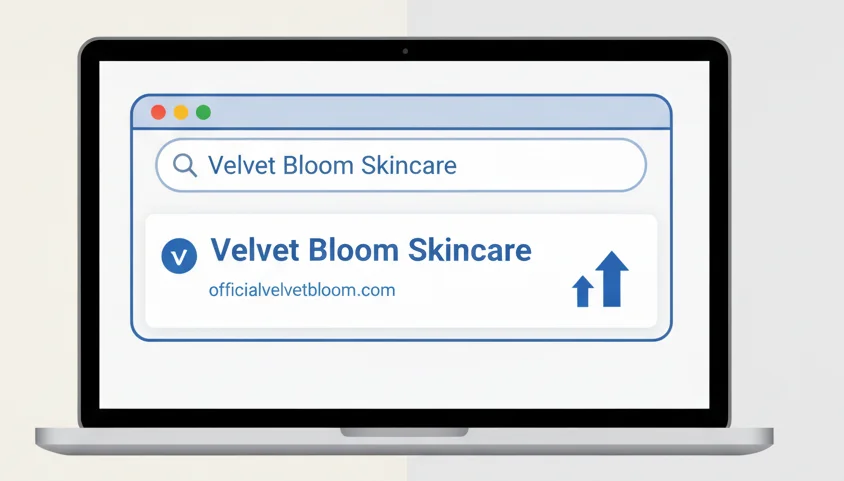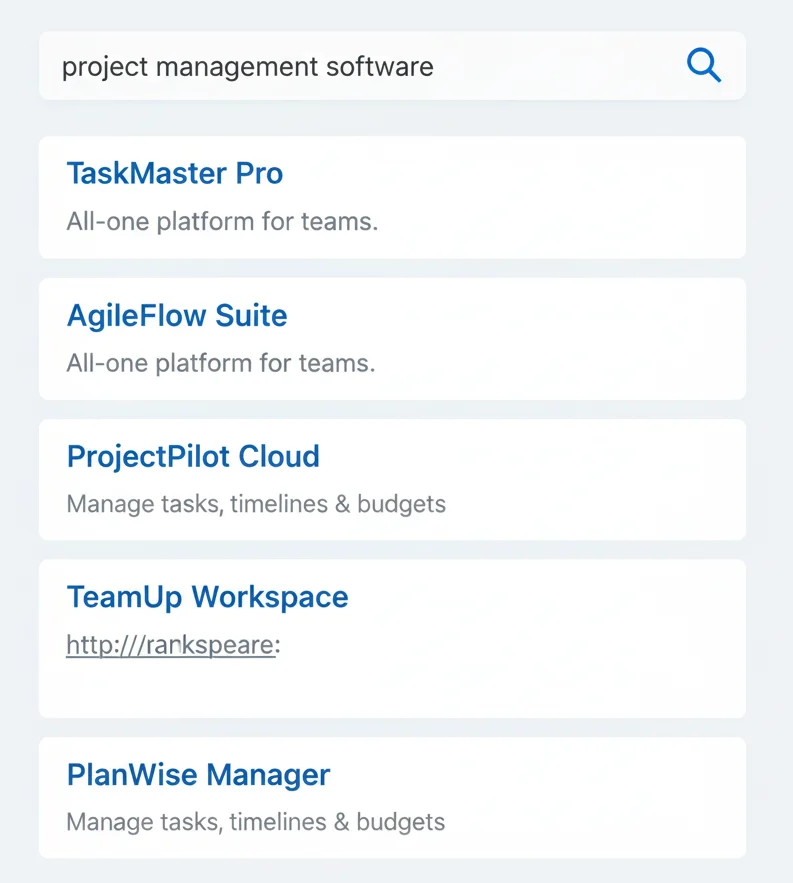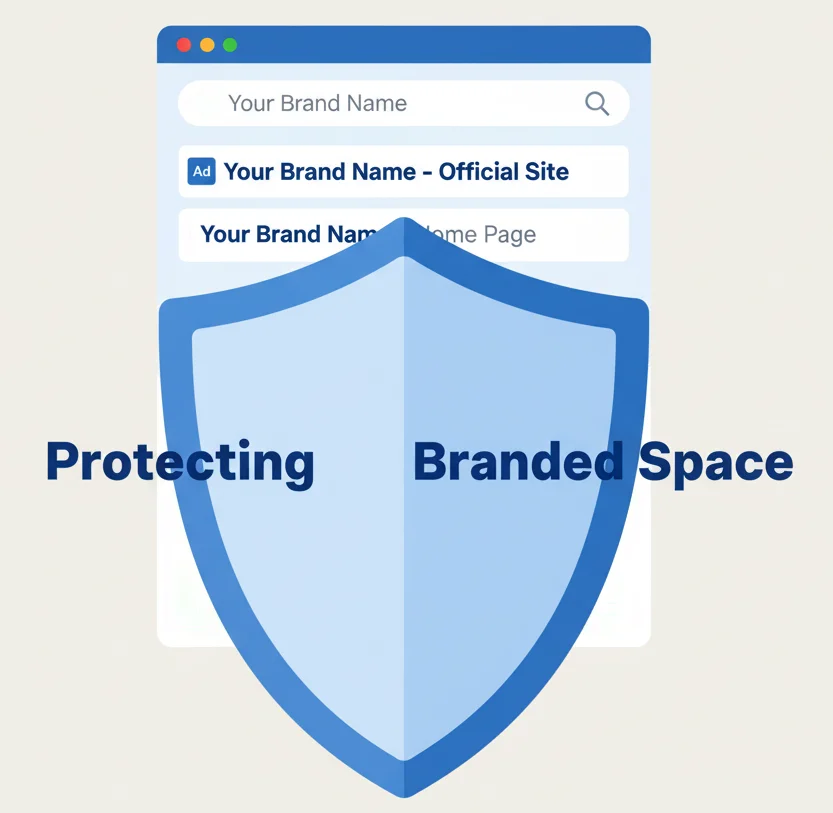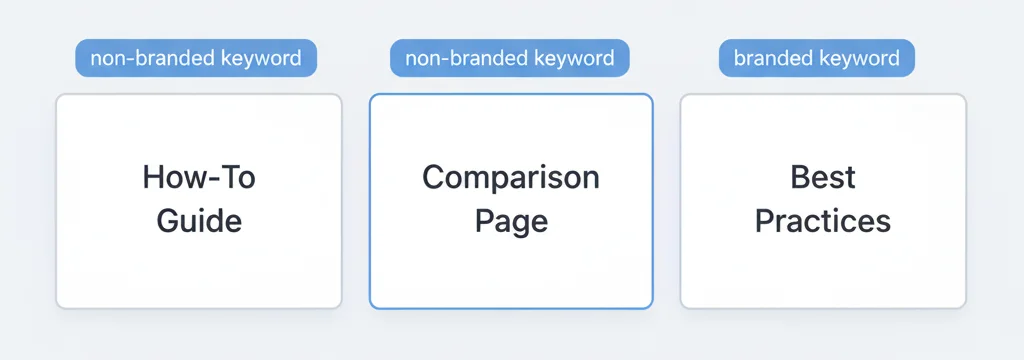Understanding the difference between branded and non-branded traffic is essential for measuring the real impact of your SEO, PPC, and broader marketing efforts. Branded traffic usually reflects people who already know your company, while non-branded traffic shows how effectively you attract new audiences searching for generic solutions or categories.
By clearly separating these two traffic types in your strategy and reporting, you can see which efforts build awareness, which drive conversions, and where to focus your budget for growth. This blog walks through what each traffic type means, how they differ, and how to build a balanced strategy that uses both effectively.
What Is Branded Traffic?

Branded traffic refers to visits that come from searches or clicks containing your brand name or a close variation of it. These queries usually indicate that users already recognize your company or products and are actively trying to find you online.
Typical branded traffic includes keywords with:
- Your company name (e.g., “Acme Analytics”).
- Brand variations, abbreviations, or common misspellings.
- Product or service names that are uniquely associated with your brand (for example, a trademarked product line).
Because these users already know your brand, branded traffic is often a strong indicator of brand awareness, recall, and loyalty across online and offline channels. It is heavily influenced by non-SEO efforts like PR, offline advertising, referrals, partnerships, and word of mouth, which then show up as brand-name searches in Google and other search engines.
What Is Non-Branded Traffic?

Non-branded traffic includes visits from generic or category-level search terms that do not mention your brand name or any of its variations. These users are usually researching products, services, or problems rather than looking for a specific company.
Examples of non-branded keywords include:
- Generic product or service terms (e.g., “SEO audit tool,” “HR software”).
- Problem-focused queries (e.g., “how to improve website rankings,” “reduce employee churn”).
- Category and comparison searches (e.g., “best email marketing platforms,” “CRM vs ERP”).
Non-branded traffic is crucial for discovery because it represents people who may not yet know your brand but are actively looking for solutions in your category. In most markets, non-branded searches tend to make up the majority of organic search volume and are a major driver of new visitors and net-new customers.
Key Differences Between Branded and Non-Branded Traffic
Branded and non-branded traffic differ in intent, behavior, volume, and cost, which has direct implications for SEO and PPC strategy. Understanding these differences helps you allocate resources correctly and avoid misreading performance data.
1. Intent and user behavior

Branded searches are often navigational or transactional, meaning the user is specifically trying to reach your site or is close to a purchase decision. Because the user already trusts your brand, branded visitors tend to have higher engagement and are more likely to convert.
Non-branded searches are more likely to be informational or comparative, especially at the top and middle of the funnel. These users are learning about options, comparing providers, or exploring a problem space, so they may visit multiple sites before deciding.
2. Conversion rates and performance
Across many accounts and industries, branded keywords typically show higher conversion rates than non-branded keywords in both SEO and PPC campaigns. This is because someone who searches for your brand by name is usually further along in the buying journey and more ready to take action.
Non-branded keywords usually have lower individual conversion rates but contribute heavily to pipeline by bringing in a much larger pool of potential customers at earlier stages. When measured over time, strong non-branded performance can significantly increase the number of users who later return as branded searchers or direct visitors.
3. Volume, competition, and cost
Branded keywords generally have lower search volume because they are limited to people who already know your company. However, they often have lower cost-per-click (CPC) in PPC campaigns and higher click-through rates (CTR), as the ad is highly relevant to the query.
Non-branded keywords usually have far higher search volume but are much more competitive and expensive in paid search, since many brands fight for the same generic terms. From an organic perspective, ranking for competitive non-branded terms typically requires stronger content, more links, and a more mature SEO strategy.
4. Impact on SEO and PPC strategy

Branded traffic is critical for protecting your presence on search results pages and ensuring users who look for you can find you quickly. Non-branded traffic is crucial for growth, as it expands your reach beyond existing demand and builds a pipeline of new prospects.
In well-balanced programs, branded keywords help secure high-intent conversions efficiently, while non-branded keywords grow visibility, authority, and long-term demand in your category. Treating them as separate but complementary levers allows for more precise planning and measurement.
Also Read: Brand Bidding Strategy In 2025: Steps, Best Practices & Tips
Strategic Approaches for Branded Traffic
Branded traffic requires a strategy focused on protection, clarity, and efficient monetization of existing demand. Because you have a natural relevance advantage on your own name, the risk is less about winning visibility and more about losing it to competitors, partners, or unclear messaging.
1. Protecting brand with paid and organic efforts
Even if you rank first organically for your brand name, competitors can bid on your brand terms and appear above your organic result with paid ads. Many practitioners therefore recommend running branded PPC campaigns to ensure you control both paid and organic real estate for key brand searches.
On the organic side, it is important that your homepage, key product pages, and knowledge panels are well-optimized so that users searching your brand get accurate, up-to-date, and trustworthy information. This includes ensuring your name, logo, meta titles, and descriptions are clear and aligned across search and social profiles.
2. Handling conflicts with distributors and partners
In industries that use distributors, resellers, or retail partners, multiple entities may compete for the same branded keywords. For example, both the manufacturer and major retailers might bid on the manufacturer’s brand name, leading to internal competition and higher CPCs.
Companies often address this by:
- Agreeing on bidding rules or exclusions for specific branded terms.
- Prioritizing direct traffic for core branded queries while allowing partners more presence on product-level or category-level terms.
- Using attribution data to understand which mix of brand vs. partner traffic drives the best overall revenue and margin.
The goal is to protect brand visibility without creating unnecessary channel conflict or overspending to compete against your own ecosystem.
3. Monitoring brand cannibalization between paid and organic
Brand cannibalization occurs when paid brand campaigns capture clicks that would otherwise have gone to your organic listings. Because branded queries are highly relevant to your site, organic results often perform well without heavy paid support.
To manage this, many marketers:
- Benchmark branded organic traffic and conversions before launching or scaling brand PPC campaigns.
- Monitor changes in organic brand clicks relative to paid brand clicks to see whether paid is simply displacing organic.
- Test variations in bid levels, ad copy, and presence to find a balance where paid supports incremental value rather than just replacing free traffic.
This analysis helps ensure budgets are used to drive incremental gains instead of paying for visits that would likely have happened anyway.
Strategic Approaches for Non-Branded Traffic
Non-branded traffic requires more proactive content, SEO, and PPC work because users are not specifically looking for your company. The aim is to position your brand as a relevant and trusted answer whenever people search for problems or categories related to what you offer.
Targeting broader audiences with educational and awareness content
Since non-branded queries are often informational or exploratory, high-performing content frequently includes guides, tutorials, comparisons, and thought leadership. This type of content helps build trust early and introduces your brand while users are still researching options.
Examples of useful non-branded content include:
- How-to articles and problem-solution guides.
- Comparison pages (e.g., “tool A vs tool B” or “types of [product] and how to choose”).
- Industry explainers and best-practice resources that clarify complex topics.
By ranking for these queries, brands can capture users who later return as branded searchers or direct visitors once familiarity and trust increase.
Keyword research and optimization for long-tail non-branded terms
Non-branded optimization usually starts with detailed keyword research to find topics that align with your offerings and audience intent. Long-tail keywords—more specific, lower-volume queries—can be especially valuable because they reflect clearer intent and often have less competition.
A typical approach is to:
- Map non-branded keywords to stages of the customer journey (awareness, consideration, decision).
- Create focused content targeting each group of queries with clear on-page optimization (titles, headings, internal links).
- Continuously refine targeting based on traffic quality, engagement, and conversion paths in analytics.
Over time, this helps build topical authority and expands your footprint across a broad set of relevant searches.
Leveraging content marketing and SEO for non-branded search
Content marketing and SEO are central to non-branded strategy because they allow you to scale organic visibility in cost-efficient ways. High-quality content supported by technical SEO, internal linking, and backlinks can generate sustained traffic from non-branded queries without ongoing click costs.
In parallel, paid search can be used selectively to accelerate visibility on high-value non-branded terms while organic efforts ramp up. Segmenting paid campaigns into branded and non-branded groups allows for more precise bidding and budget allocation across different intent levels.
Tracking and Attribution
Accurately measuring branded vs. non-branded traffic is critical for evaluating SEO and PPC performance and for understanding where your growth truly comes from. Without this split, it is easy to overestimate the impact of search efforts by counting traffic that mostly reflects offline or brand-driven demand.
Importance of separating branded vs. non-branded traffic
Branded traffic is heavily influenced by campaigns, PR, offline media, and word of mouth, while non-branded traffic is more directly tied to your SEO and content efforts. If everything is reported together, increases in branded search can mask stagnant or declining non-branded performance.
Separating the two helps you:
- Measure how well SEO and content attract new audiences beyond existing brand demand.
- See whether PPC spend is driving incremental conversions or mainly capturing existing branded interest.
- Align stakeholders around realistic expectations for what SEO and PPC can control versus what is driven by broader brand and marketing activity.
Tools and methods for accurate tracking and reporting
Most analytics and advertising platforms allow you to distinguish branded from non-branded queries using filters, segments, or naming conventions. Common methods include:
- Using filters or keyword lists in analytics and search tools to tag brand-name queries as branded traffic.
- Structuring PPC campaigns into separate branded and non-branded groups, so performance is automatically reported by intent type.
- Leveraging SEO and reporting platforms that provide built-in branded vs. non-branded breakdowns for rankings, traffic, and conversions.
Automated dashboards and scheduled reports can then be used to track trends over time and share insights with stakeholders.
Making data-driven decisions based on performance
Once branded and non-branded data is separated, you can make more precise decisions about where to invest and how to optimize. For example, if branded conversions are strong but non-branded visibility is weak, you may prioritize content and SEO initiatives to capture more early-stage demand.
Conversely, if non-branded traffic is growing but branded conversions lag, that may signal a need for better brand positioning, remarketing, or nurture campaigns to convert awareness into loyalty and repeat visits. Reviewing this data regularly helps maintain a healthy balance between harvesting existing brand demand and creating new demand through discovery.
Conclusion
Branded and non-branded traffic each play distinct but complementary roles in a successful search and digital marketing strategy. Branded traffic reflects the strength of your brand and tends to convert at higher rates, while non-branded traffic demonstrates how effectively you reach new audiences and grow visibility in your category.
By defining both clearly, adopting tailored strategies for each, and separating them in your tracking and reporting, you gain a more accurate picture of performance and a clearer roadmap for where to focus resources. Ultimately, the most resilient programs protect and monetize branded demand while consistently investing in non-branded visibility to fuel long-term growth.

Passionate about blogging and focused on elevating brand visibility through strategic SEO and digital marketing. Always tuned in to the latest trends, I’m dedicated to maximizing engagement and delivering measurable ROI in the dynamic world of digital marketing. Let’s connect and unlock new opportunities together!

